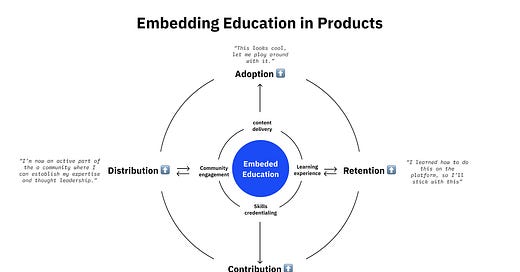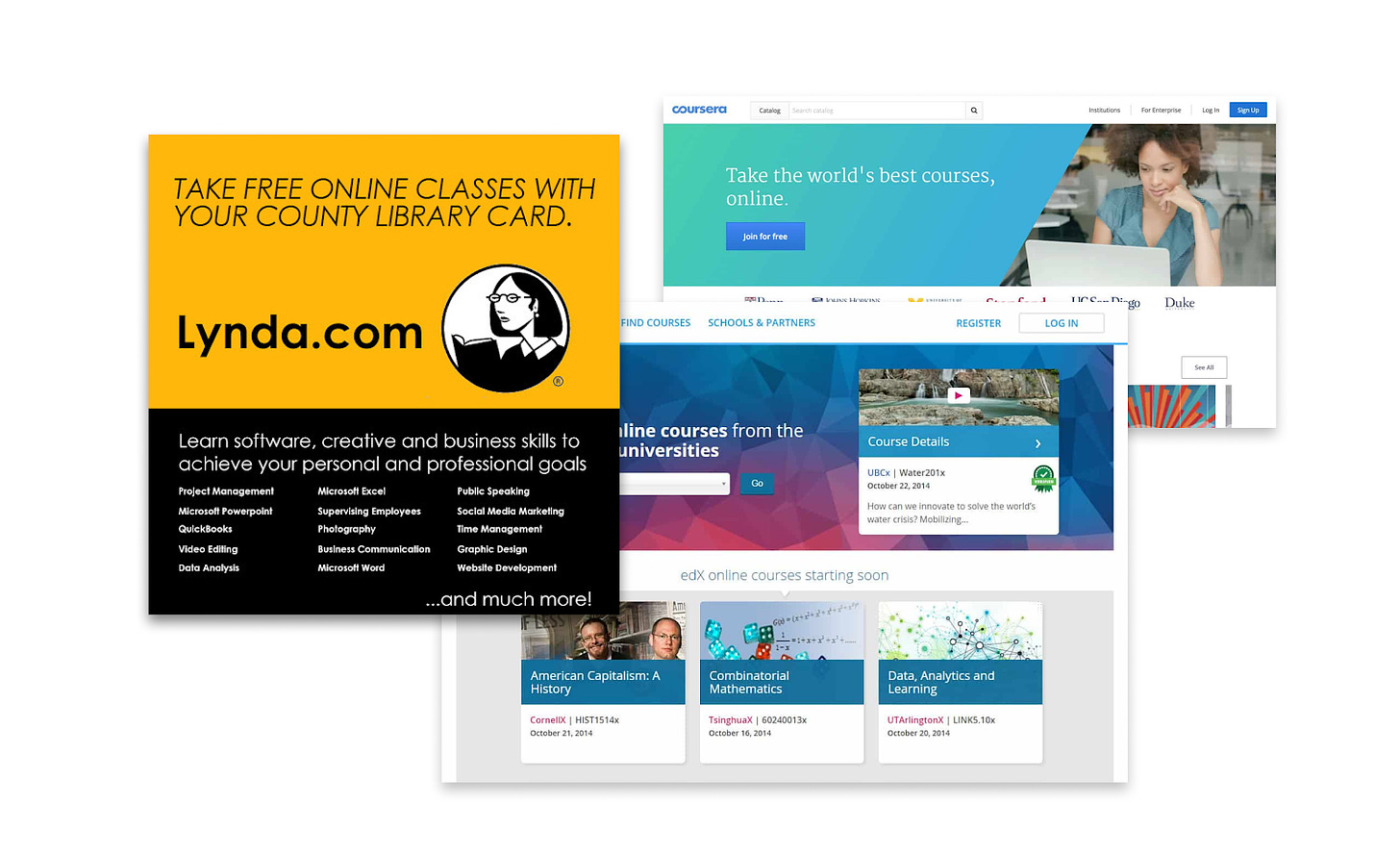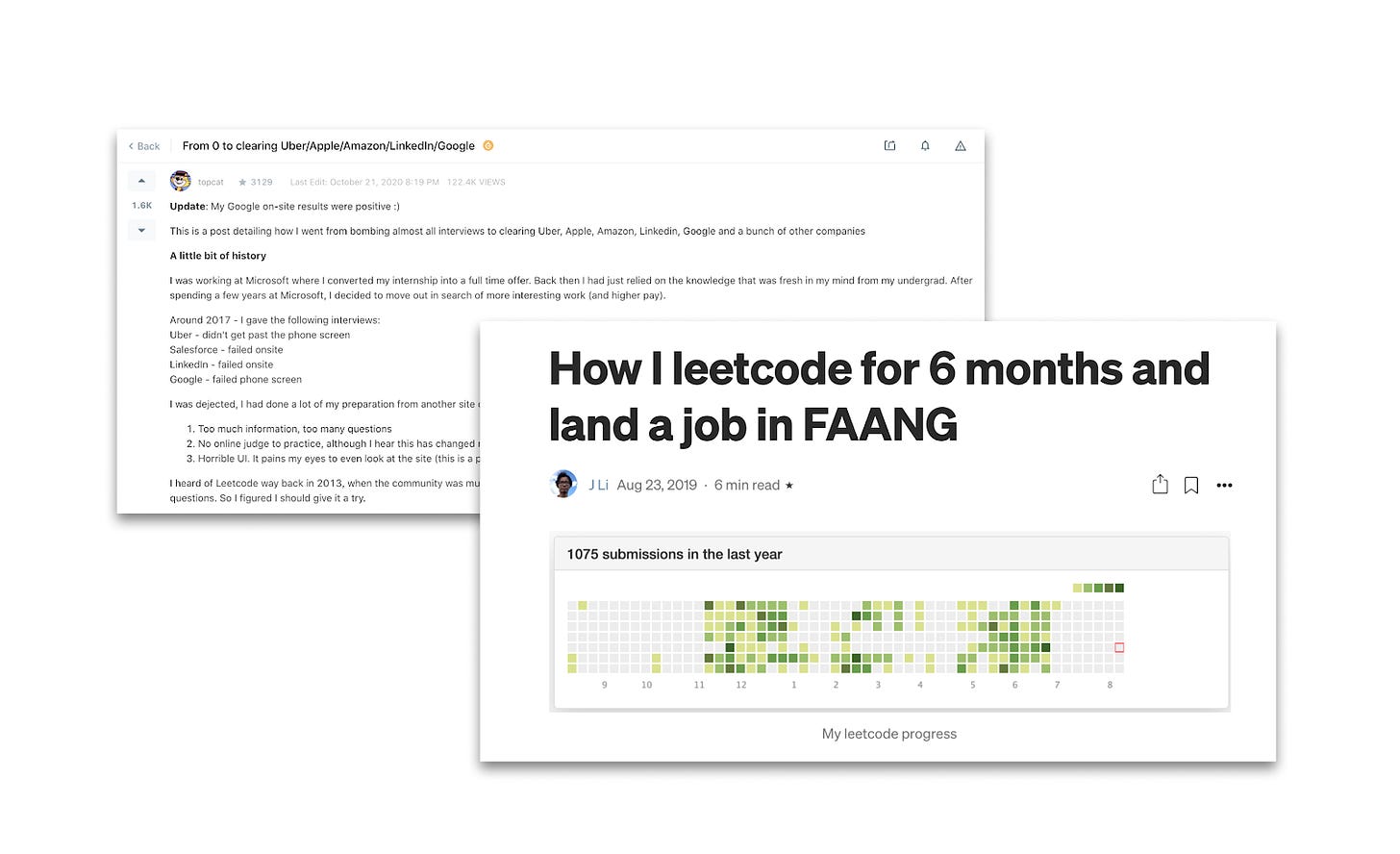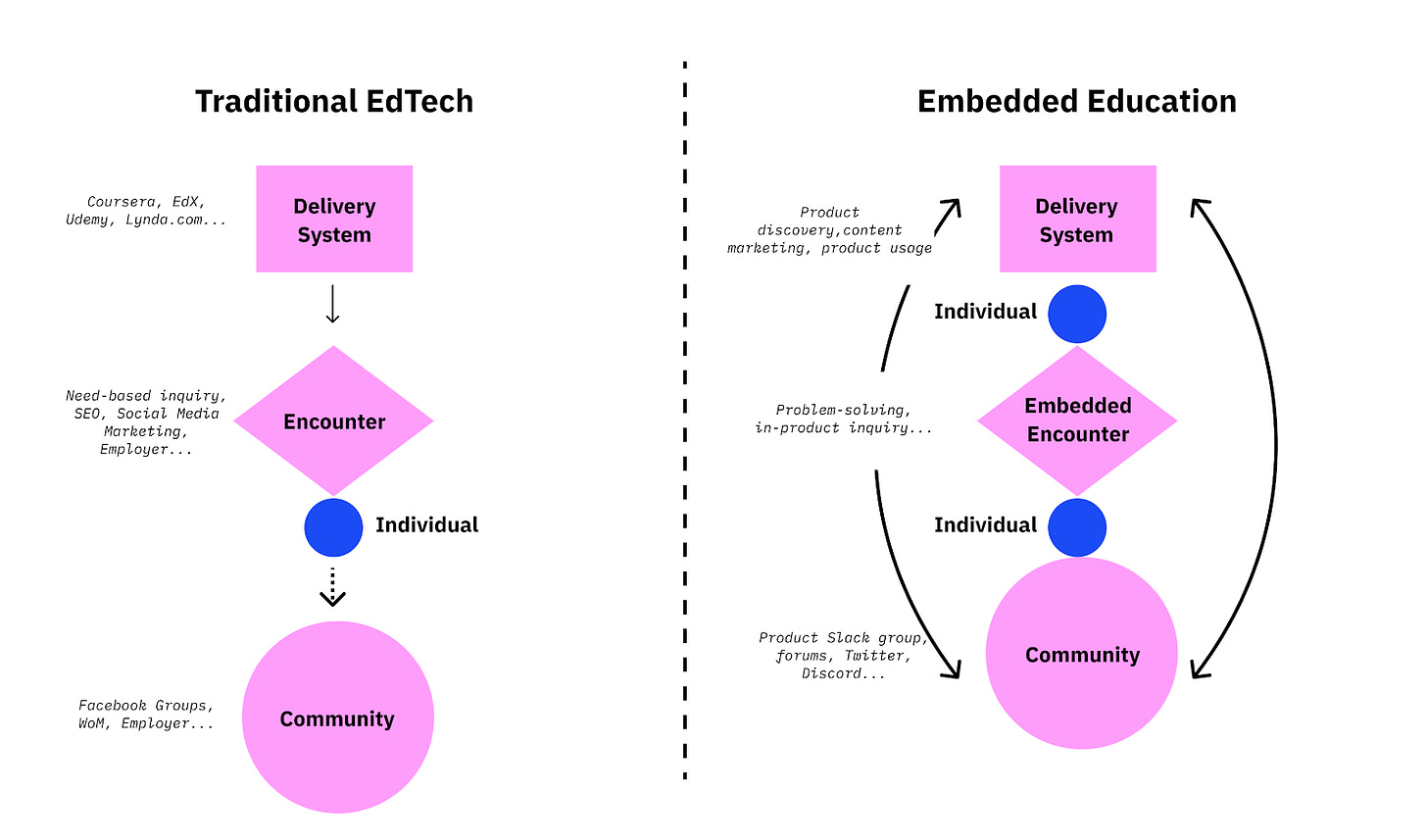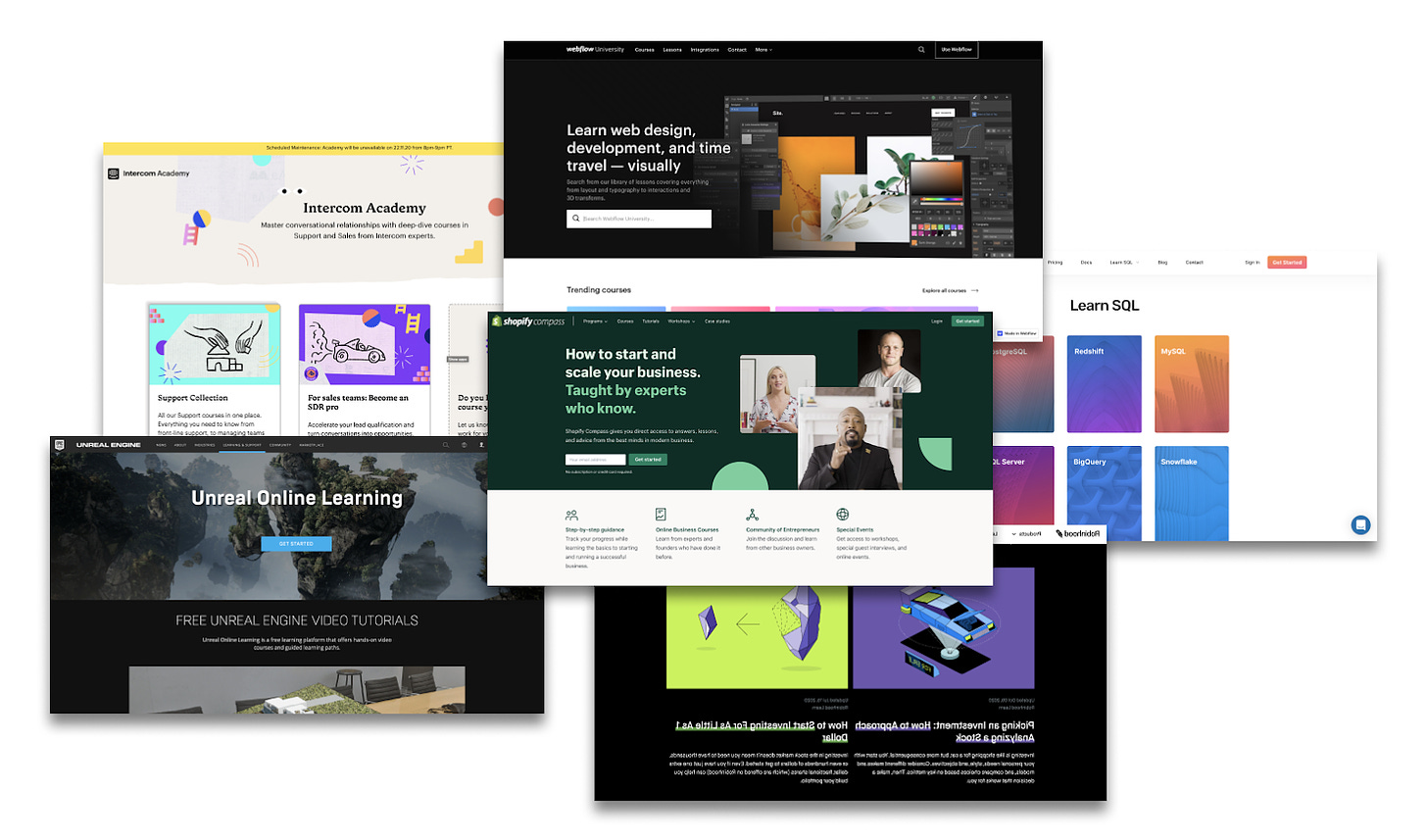[FKPXLS] SPECIAL VOLUME: Embedded Education
Learning no longer lives on an individual platform. Rather, learning happens everywhere. We’re entering a new age of “Embedded Education”.
What comes to mind when you think about EdTech companies?
The first generation of EdTech companies breaks into traditional classrooms with, well, technology. We grew up developing a love-hate relationship with Blackboard, Canvas, and Piazza, where letters of pride and shame get perpetually captured in a database of an impregnable system. In conjunction with classroom technology, we are also blessed with high-quality content on-demand, offered by some of the brightest minds of our time, making the day-to-day hustle of traveling from dorm to classroom a trial for the strong-willed. As our attention span gets spoiled by Youtube and video games, we can no longer sit still and go through a lecture for the sake of completing a lifeless test, even when everything happens in the comfort of our own rooms. The learning experience needs to be as engaging as a Youtube video or a video game. Quizlet, Duolingo, and Codecademy make learning feel just like that. Yet that alone isn’t enough. No matter how fun the game gets, learning, by the end of the day, is about applying the skills to contribute to our community. Can you confidently build a secure, functional, and fast web app for your favorite deli downstairs to take orders after being certified as a React expert on Lynda.com?
EdTech companies in the past decade have delivered a 10x product experience to the consumers through innovating on three main pillars: content delivery, learning experience, and skills credentialing. Take Coursera as an example:
Content delivery: Students now have access to content that otherwise were only available in elite universities, while providing universities additional revenue and marketing edge.
Learning experience: Students can download relative materials and follow along with learning at their own pace. The instructor no longer dictates the classroom, the student does.
Skills credentialing: Upon completion of a course, students receive a certification that they can pay for and showcase on their Linkedin or resume. Some universities also recognize them as course credits.
Community engagement: Students can ask questions directly to the teachers and be accompanied by a group of others who are in similar positions.
These EdTech companies have also innovated on content supply by morphing the idea of an instructor, providing tools and platforms that allow both esteemed professors at an Ivy League or an otherwise unknown white-collar worker to reach millions of students, and providing them attractive economic incentives to do so. The star instructors on Udemy, Skillshare, and Monthly demonstrate the scope of human potential when incentives are well-aligned. A friend who’s an experienced PM told me dedicating a few-days-worth of content creation has earned him more than $100k on Udemy.
Despite the superior product experience and the explosive growth of market participants, the liberty of a curious learner extends only as far as the palms of the invisible hands of market demand. The opportunity cost of sitting through an 80-hour course load is the ability to spend it on hacking the game directly. Legends are revered and records are being broken on platforms like Leetcode that we're able to go from 0 to a $100k FANG offer in 3 months by hacking problem sets.
Although education isn’t just about plugging us seamlessly into an infinite machine, EdTech platforms eventually need to accommodate the skill-training demand of the market as the largest revenue drivers are corporate training and credentialing. As much as we know education is more than just getting a job or gaming the system, the opportunity cost of time becomes higher in the short-term, especially in times of crisis, the need for sensemaking is reflected through the increasing consumption of media, only to find disappointing and conflicting views. We want to explore our understanding with ourselves, with nature, with one another, but it seems like we don’t really know where to start. That was once the hole to be filled by a liberal arts education, which has become increasingly unpopular due to its lack of practicality. Liberal arts have even a form of conspicuous consumption, even performance. After binge-watching the entire writing catalog of Masterclass in a few days, I’m not sure whether I’ve become a better writer, but I’ve sure become more eloquent talking about the “act of writing” when I attend my next book club.
As a super-user and a beneficiary of these EdTech platforms, I nevertheless found myself wanting more. That’s when I realized that EdTech has arrived at an inflection point, and the previous generation of companies is reaching its limits. We’ve seen from the chaos of COVID that frameworks and theories that are created with perfect preconditions can only go so far when they don’t mobilize and unite people. Many of us can solve the equation F=ma without having any feel for what the equation means. The standalone content, no matter how interactive, feels far removed from the actual context where such knowledge can be applied. The static content isn’t actionable enough to understand how it works under context, the learning experience only gets as interactive as what can be rendered on a web page, the credentialing can be deemed as trivial when work speaks louder than words, the community extends as far as asking questions in the Q&A session.
Reflecting on the past year or so, the first instinct when approaching learning a new subject is by engaging directly with the application layer, like jumping straight into the water to learn how to swim. The thought is no longer “I will go to Coursera to learn how to do this”, but rather “I’ll do it and see how it goes.” This approach is the founding principle of hackers — intentional Googling and faithful reliance on crowd-sourced wisdom. A combination of Docs reading, repo forking, Figma board replicating, CodePen project remixing, and business canvas model downloading has bootstrapped a digitally native renaissance woman. As long as there’s a doc, a template, a place to start with, I can discover a community of like-minded makers.
Learning no longer lives on an individual platform. Rather, learning happens everywhere. We’re entering a new age of “Embedded Education”. What makes phrases like “software is eating the world” or “every company is a fintech company” so powerful is that once we hear it, we can’t unsee it. Every company all of a sudden can become a software company, and every software can provide finance as a service. Once we start paying attention to Embedded Education, platforms are now filled with the potential to become some of the most effective education delivery channels.
Embedded education is the practice of educating people through encounters that they already have with systems that exist primarily for non-educational purposes. While the recently popular concept of “embedded finance” distributes financial products at the point of digital transaction, which is the most natural way for consumers to discover options, embedded education delivers learning at the point of getting the job done. From content delivery all the way to community engagement, Embedded Education is an evolution from progressive learning, which follows clear logical steps to intuitive learning, which relies less on the route memory of disparate knowledge nodes, but on the relationship between these nodes.
How do you learn about investing in stocks? Not by taking a class online, probably, but by investing with Robinhood. Robinhood launched “Robinhood Learn” to teach people the basic concepts of investing and acquired the newsletter “Snacks” to produce business-related educational content. How about building a website? Browser-based web design platform Webflow created Webflow University to teach everything from layout and typography to interactions and 3D transforms. How about conducting a team brainstorming session? How about starting a business? Collaboration tool Miro establishes its leadership in the industry not simply through a good product, but more importantly, a MiroVerse of educational templates for organizations to learn how to adopt best practices of group brainstorming. Shopify launched Compass to offer a wide range of marketing and business courses.
It’s not difficult to imagine that the more people acquire knowledge through using the platform, the more loyal and engaged they become, and eventually, the power users may even convert to “instructors” and contribute back to the educational content library. We know a company has created something special when we see organic lessons and tutorials being created beyond what the product is intended to do. Notion started off as a collaborative productivity app and has now evolved into a community where people teach each other how to live their most productive lives. Github started off as a source code management system and has turned into a way for developers around the world to learn about new subjects. Slack started off as a communication portal for gamers and quickly evolved to be a lightweight standard for productivity optimization. The learnings are available for all, but the specific lessons learned wouldn’t provide as much value to people that are not users of the platform, therefore creating scarcity around particular skill sets. The carrier of the knowledge also becomes a stakeholder of the platform, and the more the platform scales, the more valuable the knowledge becomes.
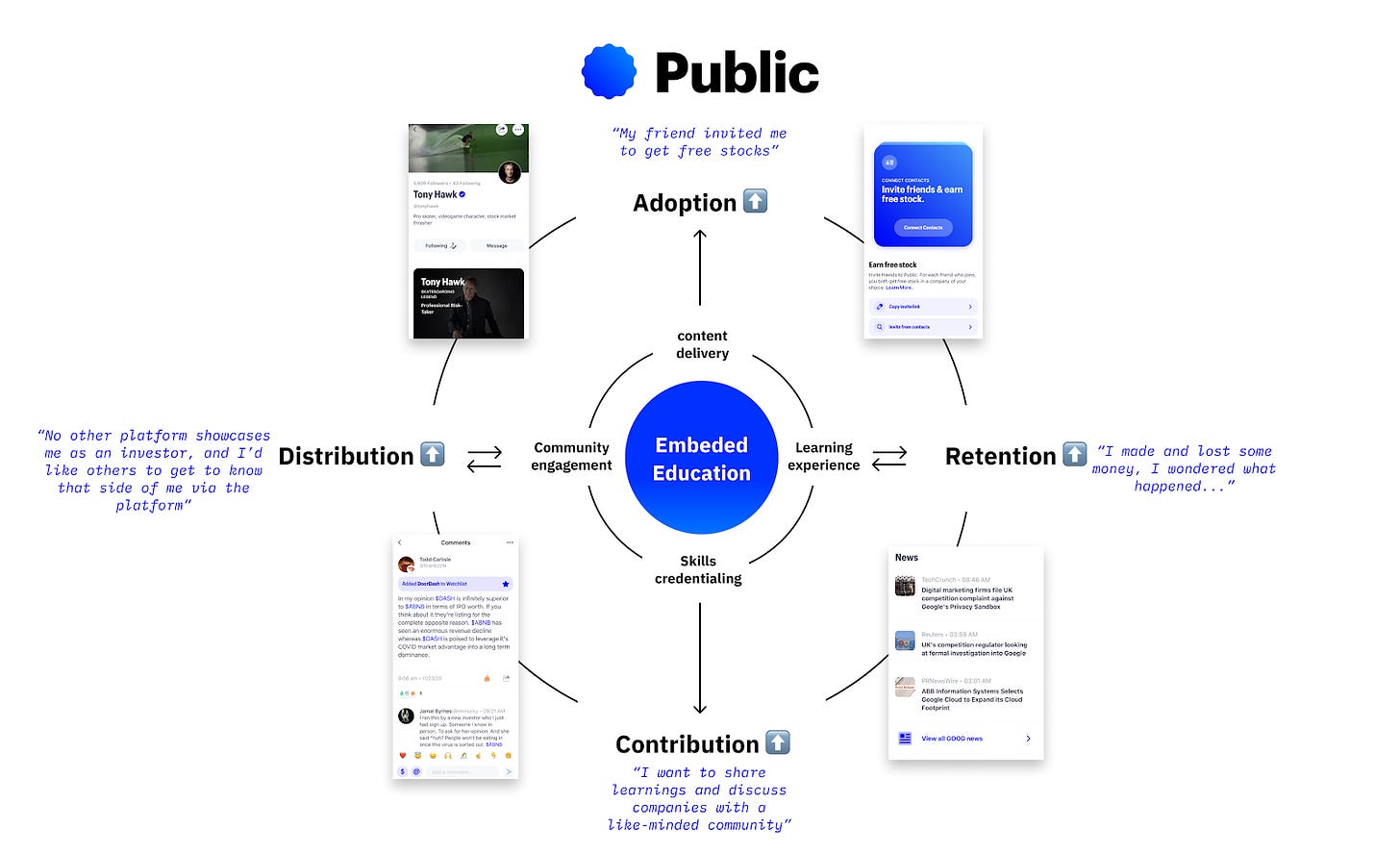
Enabled by easier-than-ever tutorial creation tools such as Loom, customer experience automation tools such as Hyro, product adoption tool such as UserLane, knowledge management system such as Guru, any company can easily create educational content embedded in the customer’s journey, and the most powerful learnings are not usually how to use your product, but about how after being a part of the product ethos, someone’s view of possibilities gets enlarged and enriched.
If the purpose of education is to inspire courage to expand our collective understanding of the world, the vision of Embedded Education is that every time we see something that inspires us, the path to actualizing this new-found dream starts right where we find it. Like watching an NBA player who dunks a basketball, in the digital world, we can pick up the ball wherever it’s left off.
Perhaps most importantly, Embedded Education can contribute to a more equitable and effective distribution of knowledge, skills, and information. By leveraging the product’s existing assets and infrastructure, platforms can deliver education and reach underserved communities much more efficiently than if one had to create new educational content from scratch. By creating real platform-native encounters rather than broadcasting information, embedded education is a more effective way to change behaviors. By shortening the feedback loop from theory to practice, it engages people to more deeply internalize what they’ve just learned.
I found myself asking: what if every company can become an EdTech company, and every person an educator? What if every product interaction is a chance to inform and inspire, rather than to complicate and obfuscate? Some of the most insurmountable barriers don’t access to resources, but access to understanding. Internet archaeologist Aaron Z. Lewis wrote in his wonderful piece “Metaphors we live by”:
Humans are pretty bad at reasoning about complex systems. In the past, our gods and demons allowed us to talk about phenomena that we didn’t fully understand. During the Enlightenment, we tried to kill them and explain everything in reductionist scientific terms. But it feels to me like we’ve come full circle. The great irony is that in our quest to disprove God, we’ve created a world that’s more magical and mysterious than Medieval people could’ve ever imagined.
Language, in the form of jargon, flowery rhetoric, and corporate buzzwords, has created walls that accrue knowledge and power. Embedded Education is an attempt to break down these walls, redistribute information and knowledge through what we already do every day.
As we continue to build more technology products, what if we start framing questions not only around problems, metrics, and the new set of glamorous features but around education. What if every touchpoint with a new participant of the platform is an opportunity to expand users’ knowledge? What if we start asking “what can we teach here that people can’t learn anywhere else?”, “How does learning about this on our platform increases the user’s capability”, and “What and how can people teach each other?” What if we ask these questions at every step of the user journey? What if the future education is no longer defined by institutions but is distributed and embedded in the everyday experience that’s already most familiar to us?
Being embedded doesn’t come without its shortcomings. My backend engineer friend shared his frustration with AWS as he’s convinced that Amazon intentionally keeps the UX extremely difficult to navigate, thereby intensifying the lock-in effect its certification program continues to justify a cost of up to $300 and breed a class of consulting companies. Just like any tool, embedded education can also be used for manipulation. However, let’s save them for the next.
I find myself thinking about a few broad themes that keep growing over time. Embedded Education is one of these ideas, and this is the beginning of an ongoing exploration. If you’re excited to ride along, would love to have you here.
If you’re new here, this is Fakepixels, a space for honest inquiry, creative courage.
We’re here to dream and agitate and question openly and unapologetically where we’re heading. We’re here to be vulnerable, honest, and true about who we are, and where we are. If you are interested in being a part of it, I would love to have you join the club.

